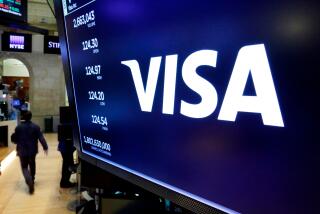Credit Card Users Paying More Than Ever Amid a âFee Frenzyâ
At the rate credit card issuers are pushing up fees, Americans could soon pay more in credit card charges than they spend to insure their homes.
Credit card users spent a record $18.9 billion last year in fees for such offenses as paying bills late or exceeding a credit limit, an industry research firm has found. Total spending for homeownersâ insurance was about $25 billion.
The explosive growth in credit card fees--up 160% since 1994--is further evidence that these charges have gone from an annoying penalty for consumers who break the rules to one of the industryâs fastest-growing sources of revenue.
âItâs turning into a fee frenzy,â said Robert McKinley, president of CardWeb.com, a leading credit card consulting firm whose research is frequently used by the industry.
Included in the $18.9-billion figure are annual fees and cash-advance fees, but most of the growth is coming from a rise in late-payment fees and over-the-limit fees. Interest payments are not included in the figure, which is based on fees charged by the industryâs top 25 credit card issuers, which control 90% of the market.
McKinley attributed the fee increases to two trends: Credit card companies are raising average fees and they are getting tougher about enforcing them. Average over-the-limit fees, which are charged when customers exceed their credit limit, have nearly doubled, from $12.50 per violation in 1994 to $23.50 today, he said. Average late-payment fees are $24 per violation.
At the same time, banks are more likely to assess fees than ever before. Today, more than 90% of credit card issuers assess late-payment fees, up from 70% five years ago. And most banks today no longer offer a grace period, so payments are counted as late if they are one day overdue, according to CardWeb.com.
Industry officials defended the tighter policies on penalty and transaction fees, saying they allow them to cut costs for those customers who abide by the rules.
âIn order to offer the low [interest rates] we have today, customers have to pay their bills on time,â said Carter Warren, executive vice president of marketing at Dallas-based First USA, the nationâs second-largest card issuer. She noted that interest rates on credit cards have dropped to an all-time low, with some companies now offering permanent rates as low as 7.99%.
Customers have noticed the industryâs tougher stance.
Teddi Alves of Huntington Beach said she got caught in a fee trap at Wells Fargo. After missing her monthly payment by four days because of a death in the family, Alves said Wells Fargo slapped her account with a $29 late-payment fee and raised her interest rate from 9.9% to 15%. The higher interest rate nearly doubled the finance charges that are added to her balance each month. That pushed her over her credit limit, resulting in a $29 over-the-limit fee as well.
Ultimately, Alves persuaded the bank to reverse the charges, she said. Bank officials declined to comment.
Some First USA cardholders are so angry over the companyâs late-payment fees that they are organizing a class-action lawsuit, claiming they were charged late-payment fees even when they paid their bills on time. Attorneys filed the federal suit in Dallas in April, accusing First USA of using late-payment fees to boost its profit.
Among the suitâs allegations are that First USA failed to process payments in a timely fashion and levied late fees on consumers who mailed their payment as many as five days before the due date. Attorneys attributed part of the problem to a First USA policy that treats a customerâs payment as late if it is not received by 10 a.m. on the due date.
âItâs an unreasonable policy,â said Dallas attorney Britton Monts of Monts & Ware.
First USA spokesman David Webster said the company believed that the lawsuit has no merit. But First USA did recently admit that a problem at a Phoenix processing center used by First USA resulted in some delayed payments and improper late charges between November and March. The company would not disclose exactly how many customers were affected by the problem.
Since then, First USA has moved its processing operations to a new facility in Nevada, refunded late-payment fees for some customers and reinstated a one-day grace period, so payments received on the due date but after 10 a.m. are no longer treated as late, according to First USAâS Warren.
The rise in credit card fees began about four years ago, largely because issuers were looking for new sources of revenue to compensate for sagging interest payments, McKinley said. As baby boomers age, they are paying down their credit card debts and avoiding interest payments. About 42% of all cardholders today pay off their balance each month, up from 29% in 1990, according to McKinley.
âFaced with that kind of pressure, companies are trying to make up the revenue with new fees and higher fees,â McKinley said. He noted that some card issuers recently hiked their fees for cash advances and for using credit cards in foreign countries to as high as 4% of the amount charged.
But both Warren and McKinley agreed that they donât expect fees to rise much higher.
âThe industry has reached the point of consumer sensitivity on this issue,â McKinley said. âThereâs a fair amount of backlash out there.â
(BEGIN TEXT OF INFOBOX / INFOGRAPHIC)
Fee Squeeze
Credit card fees paid by U.S. credit card holders hit a new high of nearly $19 billion in 1998. As consumers get smarter about avoiding interest finance charges by paying off their credit cards, banks are turning to penalty fees, such as late-payment or over-the-limit fees, to boost their revenues. As a result, credit card fees are growing three times faster than interest payments.
Fee Income (in billions)
â94: $7.3
â98: $18.9
*
Interest Income (in billions)
â94: $34.8
â98: $58.1
Source: CardTrak
More to Read
Inside the business of entertainment
The Wide Shot brings you news, analysis and insights on everything from streaming wars to production â and what it all means for the future.
You may occasionally receive promotional content from the Los Angeles Times.










